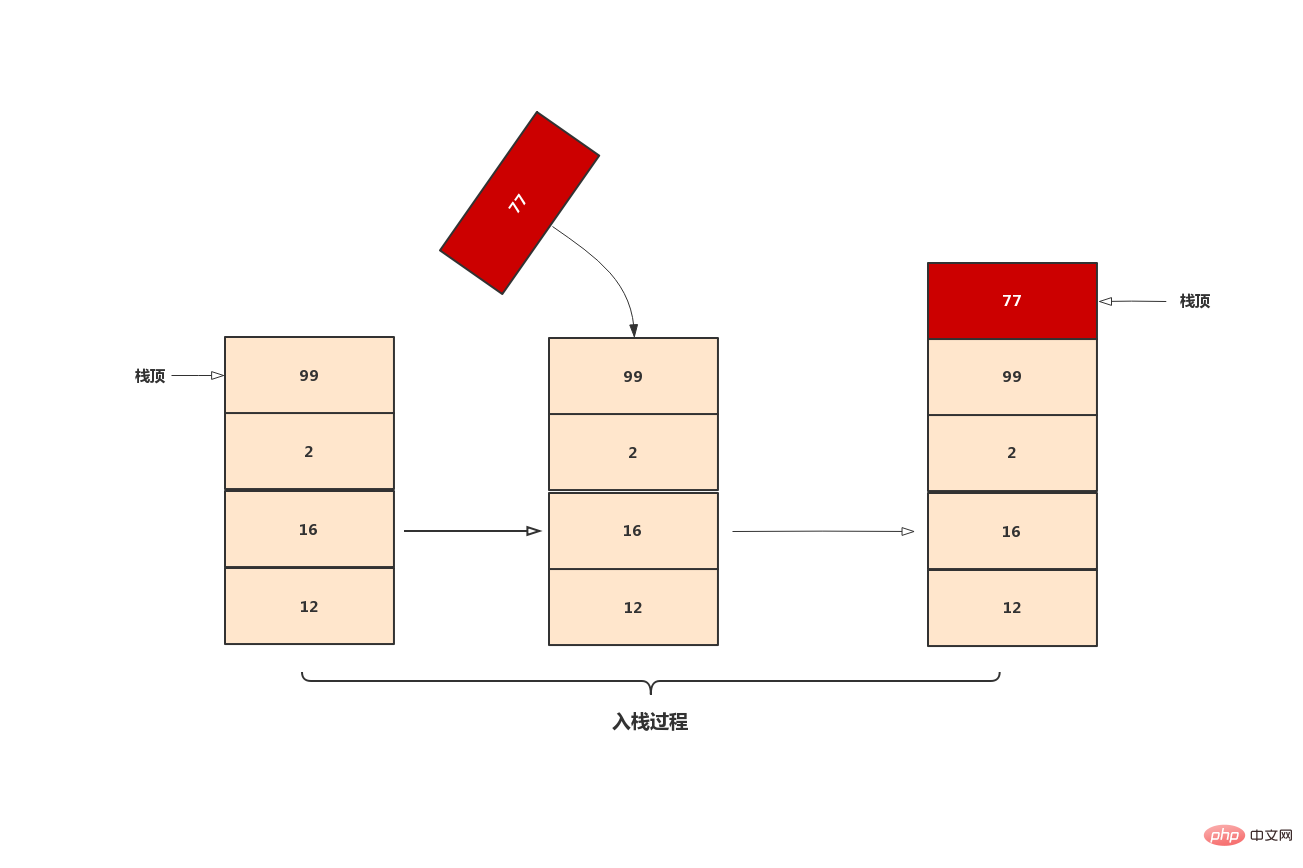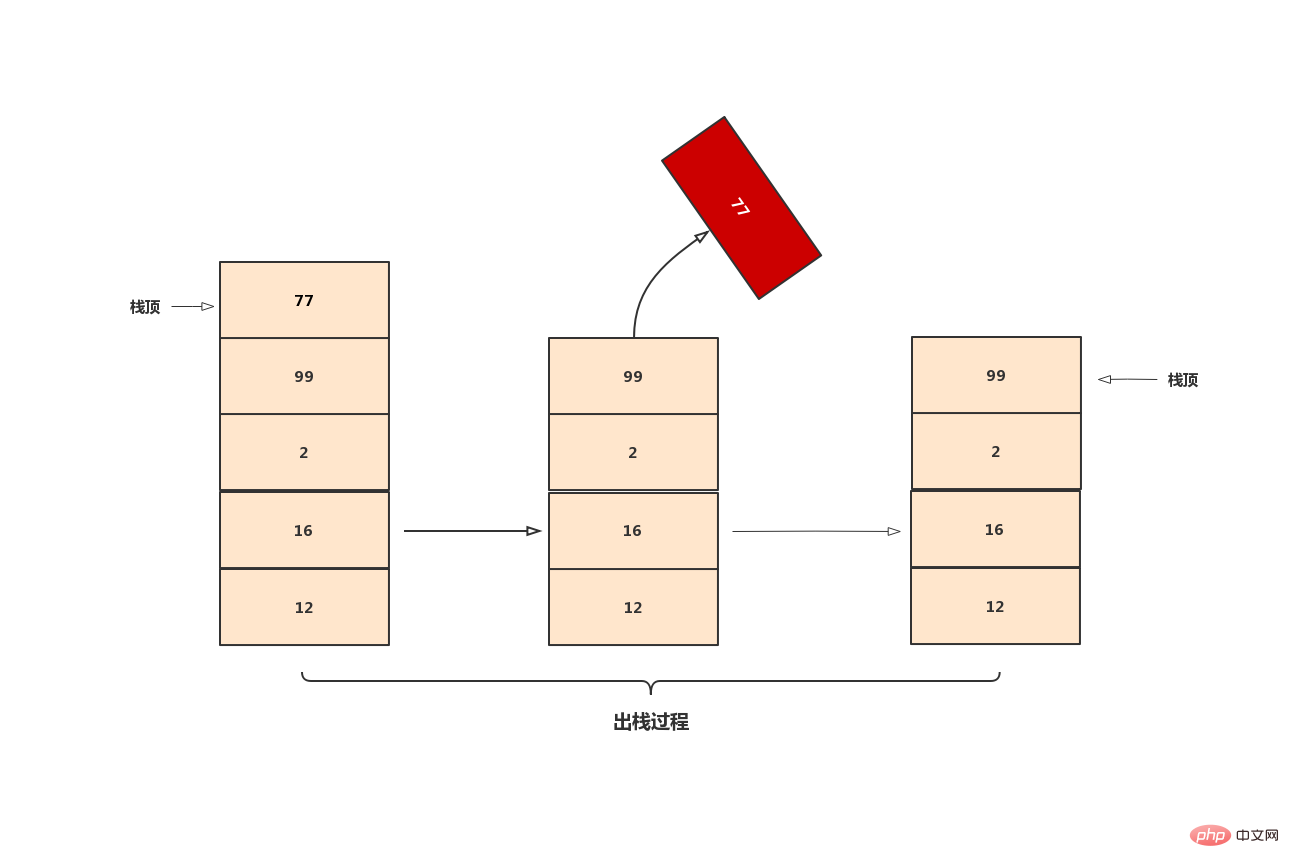Programmers, the data structure stack you should know

The stack in the data structure should not be confused with the stack in Java. They are not the same thing. The stack in the data structure is a restricted linear list. The stack has an advanced Out, last in first out characteristics, because the stack only allows access to the last data item, that is, the last inserted data item. Maybe you have questions, since the stack has so many limitations, why not use an array or linked list instead of a stack? In development, we have specific scenarios, and we choose data structures according to specific scenarios. There are many applicable scenarios for stacks, such as browser forward and backward, the legality of string brackets, etc. It is better for us to use stacks to implement , because the stack provides much fewer external interfaces than arrays and linked lists. With fewer interfaces, the probability of errors is reduced, and the controllability of risks is improved.
Recommended tutorial: PHP video tutorial
Implement one Stack
As can be seen from the definition of the stack, the stack mainly has two operations, one is to add a piece of data, which we call pushing, and the other is to obtain a piece of data, which is called Pop the stack. The following two pictures are schematic diagrams of pushing and popping the stack.


There are two ways to implement the stack. One is based on array implementation, which we call a sequential stack. The other is Implemented based on a linked list, we call it a linked stack. The following is the implementation code of the two stacks
Array-based sequential stack
/**
* 基于数组的顺序栈
*/
public class ArrayStack { // 栈最大容量
private int maxSzie; // 存放内容
private String[] array; // 栈顶元素
private int top;
public ArrayStack(int size){
this.maxSzie = size;
this.array = new String[this.maxSzie];
this.top = 0;
}
/**
* 入栈操作
*
* @param data 数据
* @return 0:入栈失败 1:入栈成功
*/
public int push(String data) {
if (top == maxSzie) return 0;
array[top] = data;
top++;
return 1;
}
/**
* 出栈操作
*
* @return
*/
public String pop() {
if (top == 0) return null;
return array[--top];
}
/**
* 获取栈顶元素
*
* @return
*/
public String peek() {
return array[top - 1];
}
/**
* 判断栈是否为空
* @return
*/
public boolean isEmpty() {
return top == 0;
}
}Linked stack based on linked list
/**
* 基于链表的链式栈
*/public class LinkStack { // 始终指向栈的第一个元素
private Node top = null;
/**
* 压栈
*
* @param data
* @return
*/
public int push(String data) {
Node node = new Node(data);
if (top == null) {
top = node;
} else {
node.next = top;
top = node;
}
return 1;
}
/**
* 出栈
*
* @return
*/
public String pop() {
if (top == null) return null;
String data = top.getData();
top = top.next;
return data;
}
/**
* 节点信息
*/
private static class Node {
private String data;
private Node next;
public Node(String data) {
this.data = data;
this.next = null;
}
public String getData() {
return this.data;
}
}
}The implementation of the stack is relatively simple, because there are not many operations involved in the stack, mainly two operations: push and pop.
Application of stack
Detect the legality of string brackets
Sometimes we need to detect the legality of string brackets, that is, a left bracket needs to match a right bracket. We can use the stack to achieve this. We can understand why the stack is used from a legal bracket? If the brackets are used legally, the last left bracket matches the first right bracket, the penultimate left bracket matches the second right bracket, and so on. This is in line with the first-in-last-out feature of our stack.
Suppose we have three kinds of brackets: round brackets (), square brackets [] and curly brackets {}. We use the stack to check the validity of the brackets. We push all left brackets onto the stack, and when a right bracket appears, we perform a match. At this time, there are three situations:
●The stack is empty, indicating that there is no left bracket and the use of brackets is illegal
●The left bracket taken out from the stack does not match the right bracket, and the use of brackets is illegal
●The left bracket taken out from the stack matches the right bracket, and the use of brackets is temporarily legal
When After the entire string is scanned, check whether there is still a value in the stack. If the stack is empty, it means that the use of brackets is legal. Anyway, the use of brackets is illegal.
Implementation code
public static boolean BracketChecker(String data) {
char[] chars = data.toCharArray();
ArrayStack stack = new ArrayStack(chars.length);
for (char ch : chars) {
switch (ch){
case '{':
case '[':
case '(':
stack.push(ch);
break;
case '}':
case ']':
case ')':
if (!stack.isEmpty()){
char ch1 = stack.pop();
if ((ch=='}' && ch1 !='{')
||(ch==']' && ch1 !='[')
||(ch==')' && ch1 !='(')
){
return false;
}
}else {
return false;
}
break;
default:
break;
}
}
return stack.isEmpty();
}Browser forward and backward functions
We all use browsers You know, the browser can move forward and backward, and the browser's forward and backward functions are also in line with the characteristics of the stack. The web page we visit first must be the last one to go back to. Let’s take a look at how the stack implements this function?
We need to define two stacks. We push the page visited for the first time into the first stack. When we click back, we take the data from the first stack and put it into the second stack. When the forward button is clicked, data is taken from the second stack and placed into the first stack. When there is no data in the first stack, it means that there is no page to click to go back. When there is no data in the second stack, it means that there is no page to click to go forward. In this way, we implement the browser forward and backward functions through the stack.
The above is the detailed content of Programmers, the data structure stack you should know. For more information, please follow other related articles on the PHP Chinese website!

Hot AI Tools

Undresser.AI Undress
AI-powered app for creating realistic nude photos

AI Clothes Remover
Online AI tool for removing clothes from photos.

Undress AI Tool
Undress images for free

Clothoff.io
AI clothes remover

AI Hentai Generator
Generate AI Hentai for free.

Hot Article

Hot Tools

Notepad++7.3.1
Easy-to-use and free code editor

SublimeText3 Chinese version
Chinese version, very easy to use

Zend Studio 13.0.1
Powerful PHP integrated development environment

Dreamweaver CS6
Visual web development tools

SublimeText3 Mac version
God-level code editing software (SublimeText3)

Hot Topics
 1377
1377
 52
52
 Compare complex data structures using Java function comparison
Apr 19, 2024 pm 10:24 PM
Compare complex data structures using Java function comparison
Apr 19, 2024 pm 10:24 PM
When using complex data structures in Java, Comparator is used to provide a flexible comparison mechanism. Specific steps include: defining the comparator class, rewriting the compare method to define the comparison logic. Create a comparator instance. Use the Collections.sort method, passing in the collection and comparator instances.
 Java data structures and algorithms: in-depth explanation
May 08, 2024 pm 10:12 PM
Java data structures and algorithms: in-depth explanation
May 08, 2024 pm 10:12 PM
Data structures and algorithms are the basis of Java development. This article deeply explores the key data structures (such as arrays, linked lists, trees, etc.) and algorithms (such as sorting, search, graph algorithms, etc.) in Java. These structures are illustrated through practical examples, including using arrays to store scores, linked lists to manage shopping lists, stacks to implement recursion, queues to synchronize threads, and trees and hash tables for fast search and authentication. Understanding these concepts allows you to write efficient and maintainable Java code.
 In-depth understanding of reference types in Go language
Feb 21, 2024 pm 11:36 PM
In-depth understanding of reference types in Go language
Feb 21, 2024 pm 11:36 PM
Reference types are a special data type in the Go language. Their values do not directly store the data itself, but the address of the stored data. In the Go language, reference types include slices, maps, channels, and pointers. A deep understanding of reference types is crucial to understanding the memory management and data transfer methods of the Go language. This article will combine specific code examples to introduce the characteristics and usage of reference types in Go language. 1. Slices Slices are one of the most commonly used reference types in the Go language.
 PHP data structure: The balance of AVL trees, maintaining an efficient and orderly data structure
Jun 03, 2024 am 09:58 AM
PHP data structure: The balance of AVL trees, maintaining an efficient and orderly data structure
Jun 03, 2024 am 09:58 AM
AVL tree is a balanced binary search tree that ensures fast and efficient data operations. To achieve balance, it performs left- and right-turn operations, adjusting subtrees that violate balance. AVL trees utilize height balancing to ensure that the height of the tree is always small relative to the number of nodes, thereby achieving logarithmic time complexity (O(logn)) search operations and maintaining the efficiency of the data structure even on large data sets.
 Full analysis of Java collection framework: dissecting data structure and revealing the secret of efficient storage
Feb 23, 2024 am 10:49 AM
Full analysis of Java collection framework: dissecting data structure and revealing the secret of efficient storage
Feb 23, 2024 am 10:49 AM
Overview of Java Collection Framework The Java collection framework is an important part of the Java programming language. It provides a series of container class libraries that can store and manage data. These container class libraries have different data structures to meet the data storage and processing needs in different scenarios. The advantage of the collection framework is that it provides a unified interface, allowing developers to operate different container class libraries in the same way, thereby reducing the difficulty of development. Data structures of the Java collection framework The Java collection framework contains a variety of data structures, each of which has its own unique characteristics and applicable scenarios. The following are several common Java collection framework data structures: 1. List: List is an ordered collection that allows elements to be repeated. Li
 Learn the secrets of Go language data structures in depth
Mar 29, 2024 pm 12:42 PM
Learn the secrets of Go language data structures in depth
Mar 29, 2024 pm 12:42 PM
In-depth study of the mysteries of Go language data structure requires specific code examples. As a concise and efficient programming language, Go language also shows its unique charm in processing data structures. Data structure is a basic concept in computer science, which aims to organize and manage data so that it can be accessed and manipulated more efficiently. By in-depth learning the mysteries of Go language data structure, we can better understand how data is stored and operated, thereby improving programming efficiency and code quality. 1. Array Array is one of the simplest data structures
 PHP SPL data structures: Inject speed and flexibility into your projects
Feb 19, 2024 pm 11:00 PM
PHP SPL data structures: Inject speed and flexibility into your projects
Feb 19, 2024 pm 11:00 PM
Overview of the PHPSPL Data Structure Library The PHPSPL (Standard PHP Library) data structure library contains a set of classes and interfaces for storing and manipulating various data structures. These data structures include arrays, linked lists, stacks, queues, and sets, each of which provides a specific set of methods and properties for manipulating data. Arrays In PHP, an array is an ordered collection that stores a sequence of elements. The SPL array class provides enhanced functions for native PHP arrays, including sorting, filtering, and mapping. Here is an example of using the SPL array class: useSplArrayObject;$array=newArrayObject(["foo","bar","baz"]);$array
 Hash table-based data structure optimizes PHP array intersection and union calculations
May 02, 2024 pm 12:06 PM
Hash table-based data structure optimizes PHP array intersection and union calculations
May 02, 2024 pm 12:06 PM
The hash table can be used to optimize PHP array intersection and union calculations, reducing the time complexity from O(n*m) to O(n+m). The specific steps are as follows: Use a hash table to map the elements of the first array to a Boolean value to quickly find whether the element in the second array exists and improve the efficiency of intersection calculation. Use a hash table to mark the elements of the first array as existing, and then add the elements of the second array one by one, ignoring existing elements to improve the efficiency of union calculations.



